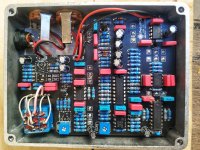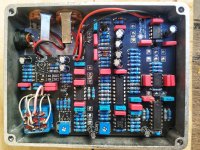effectism
Member
Hi all.
I built the Low Tide pedal “kit”.
At a first glance it works well. But I noticed something that’s strange to me. I don’t know if this happens to others.
Without any adjustment, the GATE potentiometer (LPG), acted almost as a GATE only, and not also as a variable low pass filter too (as it should). I guess that was normal, it needed adjustment.
I adjusted the “GATE” trimmer on the PCB so that the results of rotation of the “GATE” (LPG) potentiometer were satisfying for me.
But if I switch the pedal off and wait some time and then switch it back on, the “GATE” trimmer has to be readjusted. “GATE” (LPG) potentiometer acts again as a GATE only and the input signal sounds intermittently .
It seems to me that this has to do with temperature… If I “spray” (from a distance of course) the PCB with a freezer spray, or warm it (again from a distance for safety reasons) with a hot air gun, the circuit changes its behavior dramatically. This is obvious with the “GATE” (LPG) potentiometer function (only GATE, no variable low-pass filter).
Does anybody have similar issues?
I would appreciate If someone could help…
I built the Low Tide pedal “kit”.
At a first glance it works well. But I noticed something that’s strange to me. I don’t know if this happens to others.
Without any adjustment, the GATE potentiometer (LPG), acted almost as a GATE only, and not also as a variable low pass filter too (as it should). I guess that was normal, it needed adjustment.
I adjusted the “GATE” trimmer on the PCB so that the results of rotation of the “GATE” (LPG) potentiometer were satisfying for me.
But if I switch the pedal off and wait some time and then switch it back on, the “GATE” trimmer has to be readjusted. “GATE” (LPG) potentiometer acts again as a GATE only and the input signal sounds intermittently .
It seems to me that this has to do with temperature… If I “spray” (from a distance of course) the PCB with a freezer spray, or warm it (again from a distance for safety reasons) with a hot air gun, the circuit changes its behavior dramatically. This is obvious with the “GATE” (LPG) potentiometer function (only GATE, no variable low-pass filter).
Does anybody have similar issues?
I would appreciate If someone could help…


